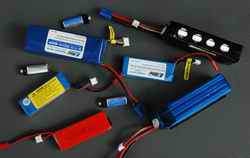 It would seem by the number of e-mails I get on the topic of RC LiPo Batteries, it is time to build a page to help answer the most common questions and perhaps dispel some myths.
It would seem by the number of e-mails I get on the topic of RC LiPo Batteries, it is time to build a page to help answer the most common questions and perhaps dispel some myths.This is a big topic and a long write-up, probably why I kept putting it off. I am not going into a deep explanation of battery physics here; if you want that kind of information check this site out : www.batteryuniversity.com
That site is one of the best battery theory resources I have found to date. My little RC LiPo battery page here goes over the most common questions I seem to be getting asked. I get asked about RC Battery Chargers all the time, here is my Battery Charger page if you want to learn about what to look for in a good charger.
What are LiPo batteries and why are they so popular in the RC world?
LiPo batteries (short for Lithium Polymer) are a type of rechargeable battery that has taken the electric RC world by storm, especially for planes and helicopters. They are the main reason electric flight is now a very viable option over fuel powered models.
RC LiPo batteries have three main things going for them that make them the perfect battery choice for RC planes and even more so for RC helicopters over conventional rechargeable battery types such as NiCad, or NiMH.
In short, LiPo’s provide high energy storage to weight ratios in an endless variety of shapes and sizes.
These benefits are important in any RC model, but for airplanes and helicopters they are the reason electric flight has become so popular. Face it, electric cars and boats have been around for decades, it wasn’t till LiPo battery technology arrived on the scene, that electric planes and helicopters started showing up and are rivalling nitro power in terms of performance.
There are a few down sides with RC LiPo batteries however; once again proving there is no perfect solution.
Before I start talking about the actual care & ratings of RC LiPo batteries, I thought I should go over the basics first. Feel free to skip down the page if you don’t care about the actual make up of a lithium battery and just “want to know what the heli to do with them and what to look for when buying them”.
Differences in Lithium Ion (Li-Ion) Lithium Polymer (LiPo) batteries...
In the RC world today, most battery packs are of the LiPo type. I thought I should include a short discussion on the Li-Ion type of pack just in case you come across one as they are used in some higher end radios. Li-Ion and LiPo batteries have essentially the same chemical make-up and are cared for in the same way; the differences are in how the cells are packaged and the type of electrolyte that is used.
Li-Ion
Li-Ion batteries use an organic liquid solvent as the electrolyte. This electrolyte is responsible for the ion exchange between the electrodes (anode and cathode) just like any type of battery. This organic solvent based electrolyte is highly flammable and the reason why Li-Ion batteries are more volatile and can catch fire or explode if mistreated. Li-Ion batteries are usually encased in a hard metal can (again like a more conventional battery) adding weight and not allowing many different options as far as shape and size.
LiPo
A true LiPo battery doesn’t use a liquid electrolyte but instead uses a dry electrolyte polymer that resembles a thin plastic film. This film is sandwiched (actually laminated) between the anode and cathode of the battery allowing for ion exchange – thus the name lithium polymer. This method allows for a very thin and wide range of shapes and sizes of cells.
The problem with true LiPo cell construction is the ion exchange through the dry electrolyte polymer is slow and thus greatly reduces the discharge and charging rates. This problem can be somewhat overcome by heating up the battery to allow for a faster ion exchange through the polymer between anode and cathode, but is not practical for most applications.
If they could crack this problem, the safety risk of lithium batteries would be greatly reduced. With the big push towards electric cars and energy storage, there is no doubt some pretty huge developments will be made in ultra light weight dry and safe LiPo’s in the coming years. Seeing that theoretically this type of battery could be made flexible, almost like a fabric, just think of the possibilities.
LiPo Hybrids
All RC LiPo batteries out there at the time of this write up (May/09) are actually a hybrid lithium polymer battery. The correct name for this type of battery is lithium-ion polymer, but the battery world of today simply calls them lithium polymer even though they are not a true dry type LiPo battery.
By introducing a gelled electrolyte into the polymer, the ion exchange rate is improved immensely. Since the electrolyte is gelled, there is less chance of leakage, but it is still flammable. LiPo hybrids are not as dangerous as Li-Ion’s but they can still catch fire or explode if over charged, shorted, or punctured.
When first introduced, LiPo batteries were more expensive than Li-Ion because they are more difficult to manufacture. Fortunately prices have dropped substantially since they have become as, if not more popular than Li-Ion battery technology. This holds especially true for electric powered RC aircraft and the real driver behind LiPo battery research – portable communication/entertainment devices.
LiPo hybrids use the same flat cell structure as their dry counter parts meaning they have the same flexibility with sizes and shapes allowing for very specialized shaped battery packs perfect for use in our RC models.
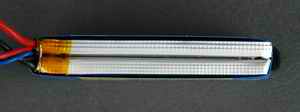 Almost every RC LiPo battery cell is packaged in a foil pouch coincidentally called a pouch cell. The picture to the right shows a typical 2 cell LiPo RC battery pack.
Almost every RC LiPo battery cell is packaged in a foil pouch coincidentally called a pouch cell. The picture to the right shows a typical 2 cell LiPo RC battery pack. Pouch cells are the perfect solution for building multi celled battery packs since the flat pouch cell can be stacked with no wasted air spaces like found within round celled battery packs. Of course since LiPo’s use this light weight pouch instead of a metal can, less weight is the result making LiPo’s the best choice over Li-Ion in a weight conscious application such as RC aircraft.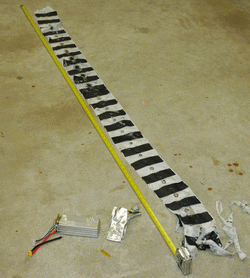 If you ever open up a LiPo foil pouch cell, this is what you will find. A long piece of very thin plastic film (the polymer) with thin carbon coated anode and cathodes in an alternating pattern on the front and back side of the polymer film.
If you ever open up a LiPo foil pouch cell, this is what you will find. A long piece of very thin plastic film (the polymer) with thin carbon coated anode and cathodes in an alternating pattern on the front and back side of the polymer film.
This long film (over 7 feet long in the case of this 5000 mAh cell), is then folded accordion style back and forth upon itself. The entire folded cell matrix is then sealed into the foil pouch along with the "greasy" gel/liquid electrolyte which incidentally has a very sweet solvent smell much like nail polish remover/acetone - no wonder it's flammable.
If you're wondering what the burnt hole is in the center of all the cell folds, I purposely drove a nail through this cell to discharge it rapidly & watch the fireworks. The cell rapidly ballooned out, burst, and vented a great deal of flammable electrolyte but never caught on fire. On the positive side, if it would have burst into flame, I wouldn't have this picture to show you the "guts". I only did this because I dropped this heavy 6S 5000mAh LiPo pack on the hard concrete floor (yes - very dumb & costly butter finger moment) and one cell was damaged in the process. Lesson learned, don't carry more LiPo's than you can safely hold!
One interesting characteristic hybrid LiPo batteries share to an extent with their dry counterparts is they do get more efficient at ion exchange once warmed up. If you have ever noticed your RC model seem to gain a little more power a minute or so after working the battery; what you are experiencing is the increase in ion exchange efficiency once the battery chemistry warms up.
This should have you thinking that if you fly your electric RC helicopter or plane in the winter time, you might want to keep your RC LiPo battery packs in a warm place prior to the flight.
LiPo RC Battery Ratings
Now that I have bored you to death on RC LiPo battery basics, time to get into the main topics at hand. First are ratings, specifically voltage and capacity. These are the two main numbers you will need when going battery shopping.. There is a third number you will also need to be aware of which I will get to in just a bit.
VOLTAGE
Unlike conventional NiCad or NiMH battery cells that have a voltage of 1.2 volts per cell, LiPo battery cells are rated at 3.7 volts per cell. The benefit here is fewer cells can be used to make up a battery pack and in some cases on smaller micro sized RC aircraft like Blade mCX's, mSR, or 120 SR one 3.7 volt cell is all that is needed to power the model.
Other than the smallest of electric RC models, RC LiPo battery packs will have at least two or more cells hooked up in series to provide higher voltages. For larger RC models that number can be as high as 6 cells and even more for larger birds or HV (high voltage) applications. Here is a list of LiPo RC battery pack voltages with cell counts most beginners will be using. If you are wondering what the 2-10S in parenthesis means; it is a way the battery manufactures indicate how my cells hooked in series (S) the battery pack contains.
I should point out you may run across packs or cells hooked up in parallel to increase the capacity. This is indicated by a number followed by a "P". Example: 3S2P would indicate 2, three celled series packs hooked up in parallel to double the capacity.
So, those are the voltages you need to know and each RC model or more specifically, the motor/speed controller combination will indicate what voltage is required for correct operation/RPM. This number has to be followed to the letter in most cases since a change in voltage equates to a change in RPM and will require changing the gearing but more likely the motor to a higher or lower Kv rating - not something I want to get into in this write-up. If a model calls for a 3 cell (3S) 11.1 volt battery – lets just say that is what has to be used unless you want to open a whole new can of worms.
A quick word on motor ratings...
Many people new to electric flight get confused by brushless electric motor ratings, specifically the Kv rating thinking Kv = kilo-volts (1 kV = 1000 volts). This is not the case at all. The Kv rating of a brushless motor refers to how many RPM it turns per volt. An example might be something like a 1000 Kv motor with a voltage range of 10 - 25 volts. That would mean this motor will turn at about 10,000 RPM @ 10 volts up to around 25,000 RPM @ 25 volts.
I don't want to start into motor ratings; battery ratings are plenty to get through... I just thought I would make mention of it since I do get that "Kilo-Volt" question often.
CAPACITY
Capacity indicates how much power the battery pack can hold and is indicated in milliamp hours (mAh). This is just a fancy way of saying how much load or drain (measured in milliamps) can be put on the battery for 1 hour at which time the battery will be fully discharged.
For example a RC LiPo battery that is rated at 1000 mAh would be completely discharged in one hour with a 1000 milliamp load placed on it. If this same battery had a 500 milliamp load placed on it, it would take 2 hours to drain down. If the load was increased to around 15,000 milliamps (15 amps) a very common current drain in a 400 sized RC helicopter while hovering, the time to drain the battery would be only about 4 minutes.
As you can see, for a RC model with that kind of current draw, it would be very advantageous to use a larger capacity battery pack such as a 2000 mAh pack. This larger pack used with a 15 amp draw would double the time to about 8 minutes till the pack was discharged.
The main thing to get out of this is if you want more flight time; increase the capacity of your battery pack. Unlike voltage, capacity can be changed around to give you more or less flight time. Of course because of size restrictions and weight you have to stay within a certain battery capacity range seeing that the more capacity a battery pack has, the larger and heavier it will be.
DISCHARGE RATE
Remember that third number I was talking about when you go RC LiPo battery shopping? Yes, discharge rate is that number. This one is probably the single most over rated & miss understood of all battery ratings.
Discharge rate is simply how fast a battery can be discharged safely. Remember that ion exchange thing further up the page? Well the faster the ions can flow from anode to cathode in a battery will indicate the discharge rate. In the RC LiPo battery world it is called the “C” rating.
What does it mean?
Well Capacity begins with “C” so that should give you a pretty good idea. A battery with a discharge rating of 10C would mean you could discharge it at a rate 10 times more than the capacity of the pack, a 15C pack = 15 times more, a 20C pack = 20 times more, and so on.
Let's use our 1000 mAh battery as an example; if it was rated at 10C that would mean you could pull a maximum sustained load up to 10,000 milliamps or 10 amps off that battery (10 x 1000 milliamps = 10,000 milliamps or 10 amps). From a time stand point, this equals 166 mA of draw a minute so the 1000 mAh pack would be exhausted in about 6 minutes.
This is calculated by first determining the mA per minute of the pack. 1000 mAh divided by 60 minutes = 16.6 mA's per minute. You then multiply that number by the C rating (10 in this case) = 166 mA of draw per minute divided into the packs capacity (1000 mA) = 6.02 minutes.
How about a 20C rating on a 2000 mAh battery? 20 x 2000 = 40,000 milliamps or 40 amps. Time wise, a 40 amp draw on this pack would exhaust it in about 3 minutes (2000/60= 33.3 mA minutes multiplied by 20c = 666 mA per minute - divided into the packs capacity of 2000 mA = 3 minutes). As you can see, that is a pretty short flight and unless you are drawing the maximum power for the entire flight, it is unlikely you would ever come close to those numbers.
Most RC LiPo Battery packs will show the continuous C rating and some are now indicating a burst rating as well. A burst rating indicates the battery discharge rate for short bursts of extended power. An example might be something like “Discharge rate = 20C Continuous / 40C Bursts”
The higher the C rating, usually the more expensive the battery - this is where you can save some money. Getting a high discharge rated pack when there is no way you could possibly pull the full amount of power is not required but it won't hurt either. The most important thing is you can't go with too low a discharge C rating or you will damage your battery and possibly your ESC (electronic speed control).
So how do you know what C rating to get when purchasing your LiPo RC Battery Pack? The easy answer most will give is to get the largest C rating you can... If money is not an object I agree with that 100%; but for most folks, especially beginners & intermediate fliers who won't be performing power hungry 3D maneuvers - stretching your RC battery budget by purchasing lower C rated packs so you can get a few extra packs makes much more sense in my opinion.
20C to 25C discharge rated packs are the norm for most 250-400 size electric helicopters with general to light sport flying in mind. For larger birds, 25C to 30C discharge rated packs are a safe bet (again for normal to light sport). Once up to aggressive sport or 3D, that is where the 35C to 45C discharge rated packs come into play.
All this said, RC LiPo packs are coming down in price all the time. If you find a 30C pack for the same price as a 20C when that is all you need, go for the 30C pack - it will run cooler and most likely last a little longer. Like most things, pushing a Lipo pack hard close to its limits will wear it out in short order. Having wiggle room on the high side will ensure that won't happen.
Lastly feel or take a temperature reading of your packs after running them. I'm afraid to say it, but just because a pack says it is rated at 20C doesn't necessary mean it is in real world applications since nothing runs at 100% efficiency and realistically, C ratings are somewhat meaningless and rarely verifiable. On top of that, as packs age the internal resistance gets higher making them run warmer and as your flying ability improves, chances are you will be pulling more current.
The general rule is if you can't comfortably hold a LiPo pack tightly in your hand after using it, it's too hot. This equates to anything higher than about 60C (140F). That is even way too warm as far as I'm concerned. Nothing higher than 50C (about 125F) is what I consider safe. So - if you find your packs are getting warmer than this, it's a good bet you should consider moving up to a higher discharge rating for your next LiPo pack.
Leaving your packs in the car on a hot sunny day can certainly heat them up past 50C as well. Internal or external heat - it makes no difference, hot LiPo's are miserable and they won't last long.
OVER DISCHARGING - THE NUMBER ONE KILLER OF LIPO'S!!!
The other thing that will heat a pack up fast is if you push it right down to or lower than 3.0 volts per cell under load. Even if you have a 40C pack and can only draw half that amount, if you push it hard right down to 3 volts per cell - it will become very warm/hot and will shorten its life substantially.
A very good rule to follow here is the "80% rule". This simply means that you should never discharge a LiPo pack down past 80% of it's capacity to be safe. For example, if you have a 2000 mAh LiPo pack, you should never draw more than 1600 mAh out of the pack (80% x 2000). This is assuming a healthy pack as well that has the full 2000 mAh capacity (as packs age, their capacity drops).
This again is where computerized chargers pay for themselves many times over so you can see how much capacity the battery takes allowing you to adjust your flight times accordingly to stay within that 80% rule to get the most life out of your pack.
If you don't have a computerized charger to confirm the amount of capacity, another good indicator is to measure the open circuit voltage (no load voltage) of the pack or individual cells after a flight/drive with a digital volt meter or other similar digital device. An 80% discharged LiPo cell, will give an approximate open circuit voltage of 3.75 volts. A 3S LiPo pack therefore would show about 11.25 volts after a flight when it's 80% discharge, a 6S pack would be about 22.5 volts.
I am often guilty of going past that 80% (3.75V per cell) number down to 90% (about 3.7 volts per cell) while flying, and on most decent quality packs if they are not being worked that hard - this is usually ok - at least in my experiences.
INTERNAL RESISTANCE
Another rating??? Yep, the first 3 are industry standards and as was mentioned with that last one (C discharge ratings), is used by the manufacturers to market their product or justify a higher price and realistically can't be verified, but they are still a good general guide line when choosing a pack.
Internal resistance to the rescue! This one is verifiable and one of the best ways to monitor your RC LiPo batteries condition. Most decent higher capacity and higher discharge rated LiPo cells will have roughly 2 to 6 milliohms (0.002 to 0.006 ohms) of internal resistance when brand new. To calculate the total internal resistance of a series wired pack, you would then add these numbers together so a 4S pack with each cell having 4 milliohms of resistance will show a total internal resistance of about 16 milliohms (0.016 ohms).
As I mentioned, as packs age, the internal resistance goes up and the warmer they run. Lower discharge rated packs and small capacity packs will generally have higher internal resistance readings. It is not unusual to measure internal resistance numbers in the region of 200 milliohms on smaller 100 to 200 mAh micro park flyer LiPo packs when they are brand new for example.
Some of my older higher capacity packs are now showing 20 to 30 milliohms per cell but they are still working fine - they do heat up a little more however during a flight, so that increasing internal resistance is certainly showing up. As I said, it is great way to monitor the condition of your LiPo packs over the months and years of service.
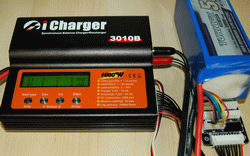 How do you measure internal resistance? This is where good computerized chargers come into play. The good ones that support this feature with built in balance boards will check the "IR" of each cell as well as the entire pack. Pictured above I am taking the IR reading of each cell in this new 6S Turnigy LiPo. It is hard to make out in the photo, but the IR of cells 1-6 are 2,2,1,1,1,2 milliohms each giving a total IR for the entire pack of 9 milliohms - pretty respectable!
How do you measure internal resistance? This is where good computerized chargers come into play. The good ones that support this feature with built in balance boards will check the "IR" of each cell as well as the entire pack. Pictured above I am taking the IR reading of each cell in this new 6S Turnigy LiPo. It is hard to make out in the photo, but the IR of cells 1-6 are 2,2,1,1,1,2 milliohms each giving a total IR for the entire pack of 9 milliohms - pretty respectable!Internal resistance really opens up a huge and complex topic of how to accurately calculate voltage drop in the pack and the total amount of watts being expended in the form of heat within the pack.
I am not going to get into those calculations here for the simple reason I am not qualified enough to explain them. If you are a number cruncher or just really want to dive head first into LiPo calculation and ratings, have a look at FMA's Lipo Evaluation ... Great stuff in there!
Charging RC LiPo Batteries
Charging RC LiPo Batteries is a topic in itself. LiPo, and Li-Ion batteries obviously have some very different characteristics from conventional RC rechargeable battery types. Therefore, charging them correctly with a charger specifically designed for LiPo batteries is critical to both the life span of the RC LiPo battery pack, and your safety.
Maximum Charge Voltage and Current
A 3.7 volt RC LiPo battery cell is 100% charged when it reaches 4.2 volts. Charging it past that will destroy the battery cell and possibly cause it to catch fire. This is important to understand once I start talking about Balancing RC LiPo batteries, so keep that in the back of your head for right now.
It is critical that you use a charger specified for Li-Po batteries and select the correct voltage or cell count when charging your RC LiPo batteries if you are using a computerized charger. If you have a 2 cell (2S) pack you must select 7.4 volts or 2 cells on your charger. If you selected 11.1V (a 3S pack) by mistake and tried to charge your 2S pack, the pack will be destroyed and most likely catch fire.
Most good RC LiPo battery chargers will use the constant current / constant voltage charging method (cc/cv). All this means is that a constant current is applied to the battery during the first part of the charge cycle. As the battery voltage closes in on the 100% charge voltage, the charger will automatically start reducing the charge current and then apply a constant voltage. The charger will stop charging when the 100% charge voltage of the battery pack equalizes with chargers constant voltage setting (4.2 volts per cell) at this time, the charge cycle is completed. Going past that, even to 4.21 volts will shorten battery life.
RC LiPo Battery Charging Current
Selecting the correct charge current is also critical when charging RC LiPo battery packs. The golden rule here use to be "never charge a LiPo or Li-Ion pack greater than 1 times its capacity (1C)."
For example a 2000 mAh pack, would be charged at a maximum charge current of 2000 mA or 2.0 amps. Never higher or the life of the pack would be greatly reduced. If you choose a charge rate significantly higher than the 1C value, the battery will heat up and could swell, vent, or catch fire.
Times are a changing...
Most LiPo experts now feel however you can safely charge at a 2C or even 3C rate on quality packs that have a discharge rating of at least 20C or more safely, with little effect on the overall life expectancy of the pack as long as you have a good charger with a good balancing system. There are more and more LiPo packs showing up stating 2C and 3C charge rates, with even a couple manufactures indicating 5C rates. The day of the 10 minute charge is not far off (assuming you have a high power charger and power source capable of delivering that many watts and amps).
Once again, the three main things that shorten LiPo battery life are: HEAT, OVER-DISCHARGING, & INADEQUATE BALANCING.
RC LiPo Battery Balancing
Finally onto RC LiPo battery balancing – what is balancing and why is it important?
Remember me telling you to keep the 100% charged voltage value of 4.2 volts per cell in the back of your head? Well, here is where that number comes into play. For a single cell (3.7 volt LiPo battery) you don’t have to worry about balancing since the battery charger will automatically stop charging when the 100% charge voltage of 4.2 volts is reached.
Balancing is required however on any RC LiPo battery pack that has more than one cell since the charger can’t identify from different cells and know if one might be overcharged even though the total voltage of the pack indicates otherwise. For example let’s look at a 3 cell LiPo battery pack (three LiPo cells hooked in series or 3S).
This would be an 11.1 volt battery pack (3.7 volts per cell x 3 = 11.1 volts). The 100% charge voltage of this LiPo pack = 12.6 volts (4.2 volts x 3 = 12.6 volts). Our trusty charger set up for a 11.1 volt RC LiPo battery pack will then stop charging at 12.6 volts – simple right.
Well what would happen if one of those three cells is charging a bit faster than the other two? There could be two cells at only 4.1 volts and the one that is charging at bit faster could be getting overcharged up to 4.4 volts before the charger stops charging at 12.6 volts. That would certainly cause damage to that one cell, perhaps even a fire.
This is an extreme example and that kind of voltage difference between cells is unlikely with a healthy pack, but even a 0.1 (100 mV) voltage difference between cells can cause issues and damage over time.
On the other end of the spectrum is if there is one cell in the pack that is not reaching full charge when the pack is charged and then gets discharged below 3.0 volts even though the 3 cell battery pack is indicating a voltage of 9 volts or higher.
Balancing ensures all cells are always within about 0.01-0.03 volts per cell so over charging or discharging of one or more cells won’t ruin your battery pack, or worse become a safety issue from overcharging a cell.
You don’t have to balance your RC LiPo battery pack each time you charge it. Most will agree every 10th to 20th time is fine with a healthy battery pack. The problem is knowing if your pack is healthy, cells in older packs may become unstable? As far as I am concerned, if you have a good balancer or balancing charger, use it at every charge, or at least at every 2nd charge. That might be overkill, but if it prevents a damaged battery or fire just once, well, you decide.
Balancing Taps & Charging
Ok, so now you know why a RC LiPo battery has to be balanced, the question now is how do you do it?
Every muti celled RC LiPo battery will have what is called a balance tap or balance plug. This plug allows individual charging or discharging of each cell in the battery pack. Here are the four main ways to balance a LiPo pack.
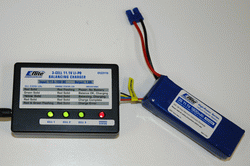
The limitation here is the maximum charge rate. Since the gauge of balance plug wiring is small, this method only works on smaller LiPo's or charge rates not much higher then 2.5 amps maximum. A good clue if you are pushing too many amps through the balance leads would be a warm/hot balance plug/wiring.
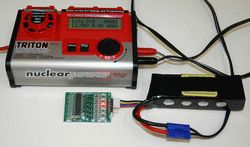
The Blinky will monitor the voltage of each cell in the pack and apply a small load to discharge any cell that is indicating a charge voltage higher than the other cells in the pack keeping all cells within about 0.02 volts (20 mV) of each other.

Obviously this method of balancing is theoretically not as safe for the LiPo pack since one or more cells could be overcharged during charging, but it will balance all the cells and keeps them in check for the discharge cycle and subsequent charge cycles.
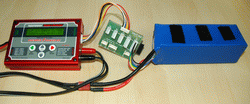
With this set-up, the battery is charged through the main power plug and the balance plug/tap is plunged into what is called a balance board which is in-turn plugged into the computerized charger in most cases; however, some chargers will have the different balance ports built into the charger eliminating the need for a separate balance board.
Good computerized chargers (like that little TP-610C pictured above) with built-in balance circuitry, will confirm correct cell count, alter the charge & balance rates, and when balancing actually occurs in the charge cycle to ensure a "stress free" and safe charge/balance cycle that extends the useful life of the LiPo pack.
This is by far the safest way to charge higher capacity multi celled LiPo's and opens up a whole new world to more advanced charging methods such as multiple pack parallel charging (the way I charge my LiPo's most of the time now).
Balancing Plugs/Taps
Balancing plugs/taps currently come in four different configurations (for the most part) and it is important to know which one your balancing charger, stand alone balancer, or balance board supports so you choose the correct plug type when purchasing your RC LiPo battery.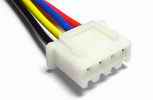 JST-XH Plug
JST-XH Plug
This is the most common balancing plug type. Used On: Align, E-Flite, Common Sense RC (V2), Great Planes, Dualsky, Esky, Electrifly, Losi, Rhino, Team Great Hobbies, Trinity, Turnigy, Venom, Zippy - just to name a few.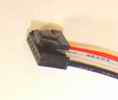 Thunder Power Plugs
Thunder Power Plugs
Used On: Thunder Power, FlightPower, Apex, EVO, MPX, Outrage, and a few other battery brands.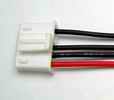 Polyquest Plugs
Polyquest Plugs
Used On: Polyquest, E-tec, True RC, Extreme Power, Impulse, Enermax, Hyperion, Poly RC, Xcite, Fliton, and a few others.
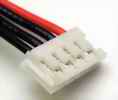 JST-EH Plugs
JST-EH Plugs
These are probably the least common type of balancing plug, but you will find them on a few big name battery brands such as: Kokam, Graupner, Core, and older Vampower battery packs.
You can get converters/adapters to use with different balancing plug configurations, but it is much easier and less costly if you just make sure you get the correct plug/tap that works with your charger when you purchase your LiPo battery.
Main Power Plugs
Once again there are several out there depending on your power handling requirements and own personal preference. Getting one type and sticking with it is the easiest way to go since all your connectors will be the same as will your charging plug/s.
Here are the 7 most common (there are certainly more): JST Connector
JST Connector
This is a small power plug rated for up to 5 amps of continuous load. It is used on smaller battery packs (usually under 1500 mAh) for powering small park fliers and micro electric helis, or for powering on board electronics (receiver, servos, gyros, governors, etc.) in higher end models with dedicated RX packs. Deans Ultra Connectors
Deans Ultra Connectors
These are a very popular connector type (also called "T" connectors) with a very loyal following, which unfortunately has driven the price up & made them one of the most expensive connectors around. They are rated for up to 50 amps of continuous load. EC3 Connectors
EC3 Connectors
EC3's are becoming very popular as they use true "bullet style" connection pins and are rated for up to 60 amps of continuous load. Most will agree bullet pins make for the best possible connection when dealing with high current applications due to a larger surface contact area.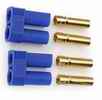 EC5 Connectors
EC5 Connectors
These are a longer version of the EC3 and because the bullet pins are longer (5mm) they have an even greater surface area for contact. EC5's are rated for up to 120 amps of continuous load. Perfect for large 1/4 scale electrics and 700 size electric helis. hexTronik XT-60 Connectors
hexTronik XT-60 Connectors
XT-60 connectors are getting more and more popular due to the very good pricing and performance. Like the EC3 connectors they use gold plated bullet pins and have a slightly higher 65 amp current rating. Made with high temperature nylon, they don't melt when soldering if you get a little carried away and they are the best plug I have ever used when it comes to the ease of plugging and unplugging.
More and more people are converting from Dean's to hexTronik XT-60's these days and are so happy they made the switch (I'm one of them). If you are just starting out with electric powered RC, you are in a wonderful position to select this plug type for medium/medium high power applications from the start! Tamiya Connectors
Tamiya Connectors
These are lower amperage connectors once very popular, especially with the electric RC car, truck, and boat crowd, but since high amp LiPo's have entered the scene, Tamiya plugs are used less and less. You still will find them used for powering smaller models and some types of nitro starting systems.
 Traxxas Connectors
Traxxas Connectors
As the name suggests, Traxxas battery connectors are used exclusively on electric Traxxas RC vehicles/boats but can be fit to any high current application up to about 100 amps. These are a nice connector that many say are one of the nicest to plug and unplug.
The three most common main power plugs you will come across (for average load applications in the RC aircraft realm) are the Deans Ultra's, the EC3's, and the XT-60's. I have used all 3 and like the EC3 and XT60's the best. EC'3 are nice because the soldering connection is concealed within the plug so you don't need to use heat shrink to insulate the solder connection. The downside is, if you ever have to unsolder the wiring from the plug, most of the time the plug is damaged trying to get the pins out.
Deans Ultras and XT-60's on the other hand could short while soldering if you are not careful - it has happened to me a couple times and the tip of my soldering iron vaporized with the huge current that arced across the pins - it wakes you up pretty fast! The other issue on the Dean's is if the heat is applied too long or at too high a temp, you will melt the actual plug or loosen the pins within the plug; the nylon XT60's are much better in this respect as well. Dean's plugs also arc excessively when plugging into high capacity ESC's, not so much so with bullet pin connectors like the XT60's and EC's. I do however find EC3's & EC5's stiffer to connect and disconnect; that is where most people find the Deans Ultra's a little easier and the XT-60 even better - they couple and uncouple very easily for the most part.
In the end, it is personal preference and more dependent on what type of plug your ESC or your LiPo's come with.
Many RC LiPo batteries and ESC's actually don’t come with any plug type (just the two wire ends insulated with heat shrink). If you purchase a battery/ESC like that, make sure you purchase the correct main plug type and ensure your soldering skills are up to the task. Otherwise, better search for a battery/ESC that comes with the correct plug type already in place. Here’s an artical & video on how to solder an EC3 connector to get an idea of what’s involved. Soldering a XT60 or Deans type T plug is very much the same, other than having to use heat shrink tubing to insulate the soldered tabs.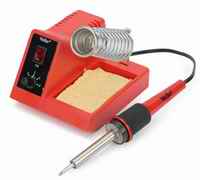 On a side note; if you are looking for a good little soldering station with adjustable heat control, check out the Weller 40 watt unit . I have had one myself for a number of years now and it is perfect for the hobbyist or electronics student.
On a side note; if you are looking for a good little soldering station with adjustable heat control, check out the Weller 40 watt unit . I have had one myself for a number of years now and it is perfect for the hobbyist or electronics student.
I should also point out balancing and main power plugs come in "male" and "female" orientations. If you are purchasing plugs for your battery or ESC, make sure you get the correct "sex".
Charging Safety
I am not going to go into a lengthy safety speech here – there are enough warnings that come with RC LiPo battery instructions that will give you all the information needed; specifically you should charge your LiPo’s in a fire safe area / fire proof charging container and never unattended. That last point is easy to print in the instructions, but rarely practical in the real world.
Personally I don’t have the time to sit down by my charging station in the workshop to keep an ever watchful eye on my LiPo packs charging - that is akin to watching the grass grow.
Here are my 4 simple LiPo Charging Safety Tips that I follow :
This may seem excessive, chances are it is... but after watching the video below, I feel these are worthwhile precautions.
Almost every documented LiPo fire has occurred as a result of physical damage to the pack, (after a crash for example, or butter fingers dropping the pack on the hard concrete floor) or during charging, and resulted from a human error. Keep that in mind if you feel these batteries are too dangerous - they are in fact very safe if the rules are obeyed - they are as safe or dangerous as you want them to be.
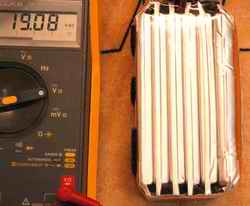 I really got an appreciation of how strong a LiPo foil pouch is even when something goes drastically wrong.
I really got an appreciation of how strong a LiPo foil pouch is even when something goes drastically wrong.Here is a picture of a 6s 5000 mAh pack that had a faulty cell and shorted internally during a flight. This one cell (the far right one) completely ballooned and got very hot - too hot to touch in fact and I was sure the pack was going to blow after I landed. That was not the case however and the foil pouch cell contained all the boiled off electrolyte. It was tight as a drum mind you, but no venting or fire occurred. A very rare occurrence, but I thought you might like to see what a swollen cell looks like.
Speaking of swollen or "puffed" LiPo packs, I get asked this question a lot. LiPo cells can and will swell a very little bit, especially if they are getting pretty warm during use. This is nothing to get too alarmed over. It is actually somewhat normal (again based on how hard you run the packs and how much they heat up) and as long as it is very-very minor swelling & goes away after the pack cools down you have nothing to worry about.
As packs age, the swelling can get a little worse (again because the internal resistance gets higher and they start running hotter). As a LiPo pack is nearing the end of it's useful life it can show some very minor swelling that won't go away, even after the pack cools. This pack may still have some nice non aggressive flights left in it however, so treat it kindly with gentler flying/driving in its early retirement before sending it to the LiPo grave yard (AKA, the trash can). Yes LiPo's are non toxic so they can be disposed of in the trash once fully discharged.
Breaking In RC LiPo Batteries
Breaking in a new LiPo pack is a good practice I feel, even though many say you don't have to do it. Just like an new engine, not pushing your new LiPo to the maximum limits the first time out may give it added life and performance over the years. The general break in method is very simple. For the first few uses (perhaps 4 or 5), don't fly/drive too aggressively, keep the charge rates low (1C or lower), and don't discharge down past 50% of the battery's capacity.
RC LiPo Battery Storage
Well, you now know how a LiPo battery works, the safety concerns, what to look for when purchasing one, how to charge and balance one and why it’s important, what more is there???
STORAGE!
How you store your LiPo’s between uses will greatly affect their life span. As I mentioned, a LiPo cell that drops below 3 volts under load is almost always & irreversibly damaged (reduced capacity or total inability to accept a charge). 3 volts under load is generally equates to about 3.5 volts open circuit resting voltage, oo if your batteries are stored for any period of time after you use them at close to that magic 3.5 volt per cell number, you risk much.
As batteries sit, they will naturally self discharge. LiPo’s are actually very good in this respect and self discharge much slower than most other rechargeable battery types, but they still do loose voltage as they sit. If you leave them for a number of weeks or months at close to 3.5 volts per cell, chances are they will drop below that and will be irreversibly damaged.
You must store them charged, but not fully charged either – that will also damage them. Basically, the speed at which a LiPo pack ages (during storage) is based on both storage temperature and state of charge. You are likely ok to store a fully charged RC LiPo battery at room temperature for up to 4 days without doing much damage. Never store a LiPo in a hot car fully charged for an extended time, that will certainly cause damage as I explained earlier, but it worth repeating.
For optimum battery life, store your RC LiPo batteries at room temperature and at about 40-60% charged. That equates to around 3.85 volts per cell (open terminal resting voltage). The actual storage range is likely a little broader than this (I have heard some say numbers as high as 20-80% is fine, but since computerized chargers set the storage charge at 50% (3.85 volts per cell) that's what I recommend and what I follow myself.
You can actually extend the fully charged storage time from days to weeks by storing your batteries in the fridge (not freezer) close to 0 degrees Celsius (32F). I have started doing this with my smaller packs seeing that I will often find myself wanting to go flying with little lead time and it is very convenient having packs all ready fully charged.
If you do store your fully charged LiPo's in the fridge, pack them in a zip-lock freezer bag and squeeze out all the air before sealing the bag. This will prevent condensation forming on the battery packs when you take them out of the fridge as they warm up. You should allow the LiPo pack to warm up after removing from the fridge before using it of course.
I only store in cold temps if I know I will be flying within a 2-3 week time frame. Once winter hits and I know my flying days will be limited, I once again store at 50% charge @ room temp. It wouldn't hurt to store at 50% charge capacity in the fridge all the time either; but it takes up precious beer chillin' real estate (priorities you know).
RC LiPo Battery Disposal Instructions
LiPo Battery Chargers
RC LiPo Battery Recommendations
I know, recommending a certain brand of RC LiPo battery is akin to telling you what beer is best (see what talking about that "cold storage" has me focusing on) - it is personal preference and everyone has their own opinion. I am also not a hot shot 3D sponsored pilot with unlimited resources; like most folks, I have to budget my pennies and stretch my dollars.
At any rate, people often ask me what RC LiPo batteries I use & recommend. As far as I am concerned, I struck gold in 2009. I have used all types of LiPo's over the past 3 years, and was pretty much a loyal FlightPower and ThunderPower guy until one of my web viewers told me about HobbyKing.com and their Turnigy & Zippy Flightmax range of LiPo batteries.
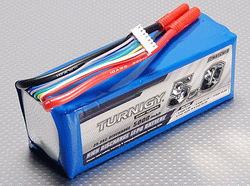 I was in a good state of mind to try something new, especially if it meant saving some serious money and making large electric flight actually affordable (up to this point, I had been dishing out $250 beans for a single 6S 5000 mAh battery pack).
I was in a good state of mind to try something new, especially if it meant saving some serious money and making large electric flight actually affordable (up to this point, I had been dishing out $250 beans for a single 6S 5000 mAh battery pack). I could get the same spec Turnigy LiPo pack for $85.00 beans (now the price has dropped to about $60.00) So I ordered one up thinking what could I loose at that price... Well, the only mistake is I didn't order more. I have since ordered 6 more 5000 mAH 6S 25C Turnigy packs for my Trex 600 and they are all working better than the FlightPower packs I have.
They don't get as warm during a flight, they have more punch throughout the entire flight, give the same amount of flight time, all cells are always in closer balance proximity after a flight, and the internal resistance is very low (1 to 2 milliohms per cell when they are brand new), not to mention bang on balance voltages after charging - testament of a good charger and good battery. Turnigy doesn't skimp on balance lead length and the balance wires are silicone making them very easy to manipulate when plugging into the balance board plus they will stand up much longer. All Turnigy and Zippy packs use JST-XH balance plugs.
I have well over 100 flights on the first Turnigy pack I ordered and it is showing next to no degradation in capacity, balance ability, and the internal resistance has only increased marginally - much better than the 2 FlightPower packs I was using with my Rex600. I of course follow my own LiPo care advice to the letter. I do charge the Turnigy packs however often at 2C since they are rated for that and have on occasion gone up to 3C when I was rushing with no problems.
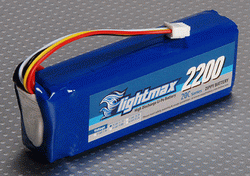 I have also ordered 5 Zippy 2200 mAh 3S 20C packs for my Blade 400 and again these things are running circles around the E-flite and ThunderPower packs I have been using with it.
I have also ordered 5 Zippy 2200 mAh 3S 20C packs for my Blade 400 and again these things are running circles around the E-flite and ThunderPower packs I have been using with it.At only $11.95 each, I was able to get 5 for less than one ThunderPower pack. So for any of you with Blade 400's, Trex 450's, or any other 400 size bird that takes 3S 2000-2200 mAh packs - you may want to check them out. They also have 25C and 30C packs for not much more.
Again, I only mention these packs since they can save you a great deal of money, but they may not be right for everyone. HobbyKing is located in China and the risk here is if there is a warranty issue, it costs a fair amount to ship the defective product back and of course the time and hassles involved. You will also have to solder on your specific style of power plug.
I now have about 30 Turnigy and Zippy LiPo's of various capacity's, cell counts, & discharge rates; so far every one of them is working fine. Unfortunately, just like that FlightPower pack, I know eventually I will get a bad one - that is the reality of the LiPo biz. For the huge money savings however, the risk for me is well worth it. The Turnigy and Zippy LiPo's come in almost every capacity, voltage, discharge rate, and size under the sun - there is something for everyone no matter what you fly or drive.
Dealing with HobbyKing.com has been hassle free and shipping is always fast (opt for expedited mail service since it only costs a few bucks more but ensures you will get fast delivery). I still maintain supporting your LHS is always the best way to go, but RC LiPo batteries in my opinion are way overpriced. Hopefully, with these very good quality and inexpensive packs on the market now, the rest of the RC LiPo battery world will take notice as more and more of us start using them - prices will then start coming down across the board I am hoping.
RC LiPo Battery Conclusion
Wow, this RC LiPo battery basics was a BIG topic! Hopefully you have a better understanding of what makes a RC LiPo battery tick, how to properly care for one, and a few recomendions. On top of that, what I really wanted to get across is that even though electric powered RC flight may not seem as complicated or fussy as fuel powered, there is much more to it than most people first realize.
No comments:
Post a Comment